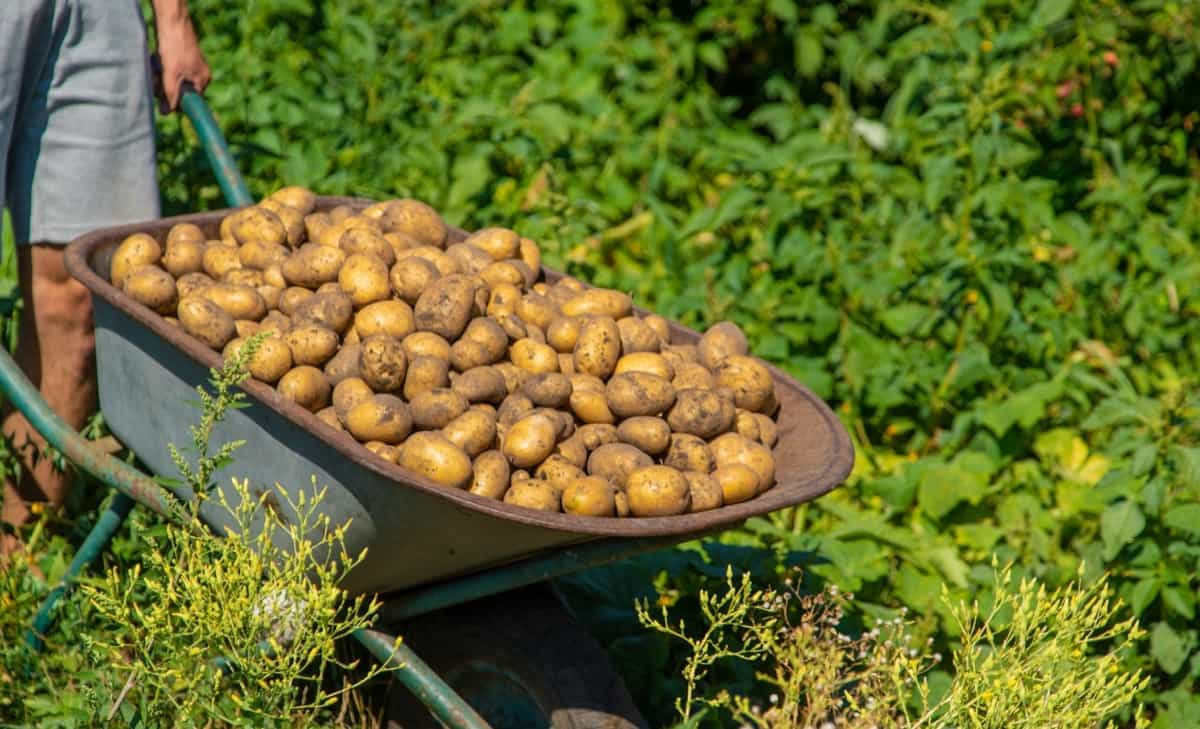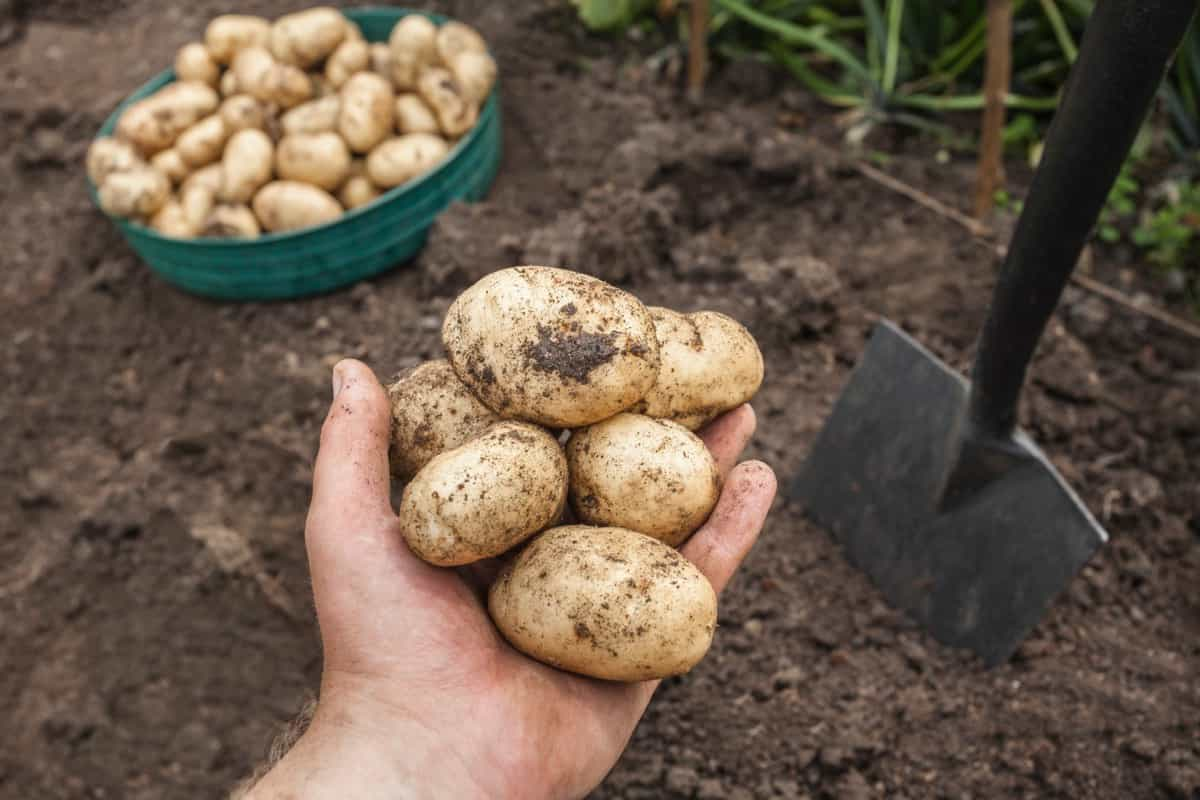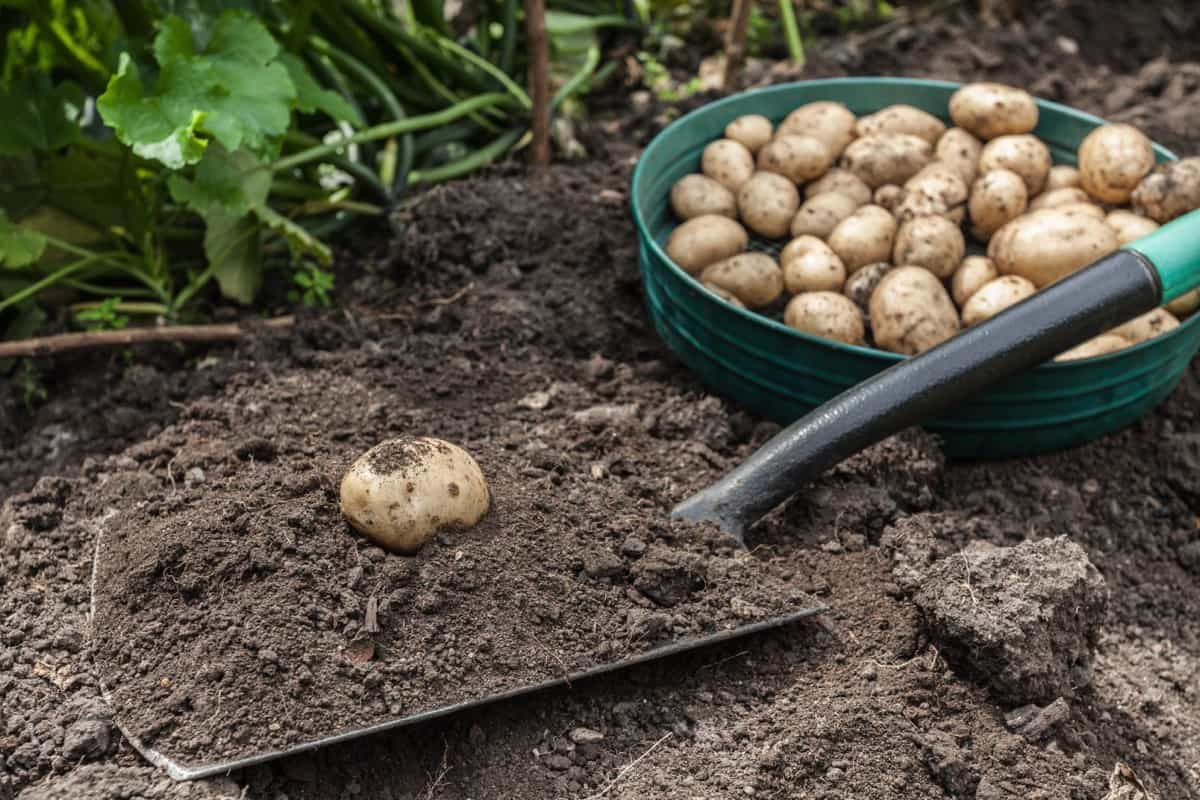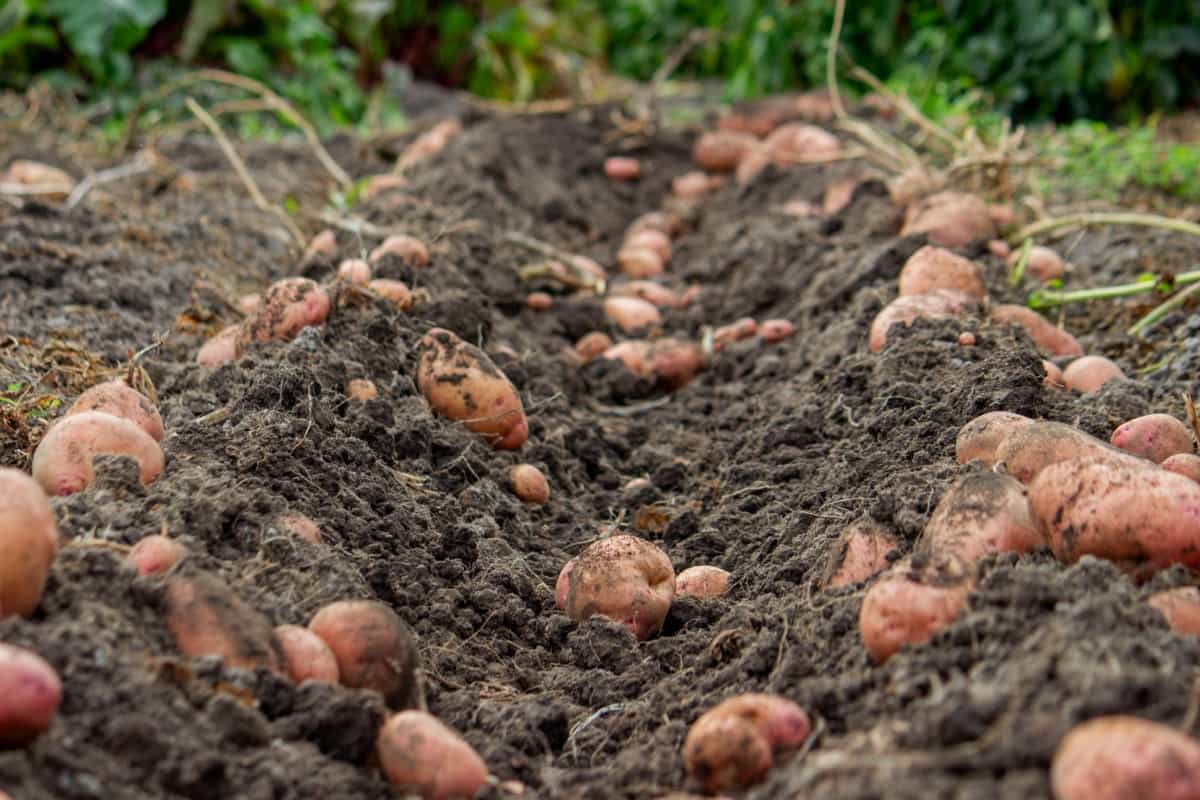Growing Potatoes can be a rewarding experience, especially when you see your plants thriving and producing a bountiful harvest. By implementing these Potato growth hacks, you can maximize the yield per plant and enjoy an abundance of delicious spuds.

By choosing the suitable variety, preparing the soil properly, providing adequate water and nutrients, utilizing companion planting techniques, protecting your plants from pests and diseases, and implementing storage tricks for long-lasting Potatoes, you’ll be well on your way to enjoying a bountiful harvest of Potatoes. Gardening is an ever-evolving process, so don’t be afraid to try new things and learn from both successes and failures. With patience and perseverance, you’ll soon become a master at growing Potatoes.
How to Get More Potatoes Per Plant
Start with Quality Seeds or Seedlings
When it comes to growing Potatoes, starting with quality seeds or seedlings is crucial for a successful harvest. Choose certified disease-free seed Potatoes from reputable suppliers. These Potatoes have been tested and proven to be free of common diseases like late blight or bacterial wilt.
By using healthy seed Potatoes, you reduce the risk of your entire crop being affected by these diseases. Consider selecting varieties that are known for their high yield potential. Look for varieties that are specifically bred for productivity and resistance to common pests and diseases. This way, you increase your chances of getting more Potatoes per plant.
Provide Adequate Sunlight
To ensure your Potato plants receive enough sunlight, choose a place that gets at least six hours of direct sun each day. Avoid planting them in areas shaded by trees or buildings, as this will limit their access to sunlight. When planting Potatoes, be mindful of spacing to prevent overcrowding and competition for sunlight among the plants.
In case you missed it: Growing Potatoes in Containers/Pots: DIY Guide for Beginners

Give each plant enough room to spread out its foliage and capture maximum sunshine. It’s worth noting that while Potatoes require ample sunlight for optimal growth, they also benefit from some shade during particularly hot periods. Providing partial shade during scorching afternoons can help prevent wilting and stress on your Potato plants.
Choose the Right Location and Soil
Choosing the best location and soil is crucial for maximizing Potato yield. Potatoes thrive in well-drained, loose soil that is rich in organic matter. Before planting, it’s important to assess the condition of your soil and make any necessary amendments. Select a spot that gets full sunlight for at least six hours a day.
This ensures optimal growth and development of Potato plants. Avoid shady spots or areas with poor air circulation, as these can lead to disease issues. Next, test the pH level of your soil. Potatoes prefer slightly acidic conditions with a pH range between 5.0 and 6.0. If your garden soil is too alkaline, you can lower the pH by adding organic materials such as compost or peat moss.
In addition to pH levels, consider the texture of your soil. Sandy soils tend to drain quickly but may require more frequent watering, while clay soils hold onto moisture longer but can become compacted easily. Loam soils are ideal for Potatoes as they provide good drainage while retaining enough moisture. Another factor to consider is fertility – Potatoes require a nutrient-rich environment to produce high yields.
Plant at the Right Time with Proper Spacing
Timing is everything when it comes to planting Potatoes. To get the most out of your Potato plants, it’s essential to plant them at the right time and give them adequate spacing. First and foremost, determine the ideal planting time for your region. Potatoes thrive in cool weather, so aim to plant them a few weeks before the last frost date in your area. This will allow ample time for growth before the summer heat sets in.
When it comes to spacing, giving each Potato plant enough room is crucial. Aim for about 12-15 inches between each seed piece or seedling. Proper spacing also helps prevent disease spread by allowing better airflow around plants and reducing moisture build-up. It’s important not to overcrowd your Potato bed – remember that healthy plants lead to healthy harvests.
Mulch and Water Potato Plants Regularly
Mulch and water are two essential elements for promoting healthy Potato growth and maximizing your yield. When it comes to mulching, using organic materials such as straw or compost can provide multiple benefits. Mulch helps regulate soil temperature, keeping it cooler during hot summer months. This creates an optimal environment for the Potatoes to grow. Moreover, mulch acts as a natural weed suppressant by preventing sunlight from reaching weed seeds.
In case you missed it: Best and Worst Companion Plants for Potatoes: A Detailed Guide

By reducing competition from weeds, your Potato plants have better access to nutrients and water in the soil. In addition to mulching, proper watering is crucial for ensuring successful Potato growth. Potatoes require consistent moisture throughout their growing season. However, overwatering can lead to rotting tubers or disease development. To strike the right balance, aim for even soil moisture by watering deeply but infrequently. Ensure that the top few inches of soil remain moist but not soggy.
Prune or Trim and Support for Optimal Growth
Pruning or trimming Potato plants may not be something that immediately comes to mind when thinking about maximizing your Potato yield. When Potato plants are left unattended, they tend to become bushy and sprawling, which can lead to overcrowding and reduced airflow within the plant canopy.
To avoid this, regularly prune or trim your Potato plants by removing any excess foliage or branches. This will help reduce the risk of fungal infections and allow more sunlight to reach the lower parts of the plant. Supporting your Potato plants is equally important for their overall health and productivity. By providing proper support, such as stakes or trellises, you ensure that the stems remain upright throughout their growth cycle.
Additionally, supporting your Potato plants helps prevent tubers from being exposed to sunlight. When Potatoes are exposed to light during their development stage, they turn green and produce solanine – a toxic compound that renders them unfit for consumption. By pruning or trimming your Potato plants regularly and providing adequate support as they grow taller, you promote healthier foliage growth while protecting developing tubers from damage caused by bending stems or exposure to sunlight.
Apply Best Fertilizers to Produce More Potatoes
Potatoes are heavy feeders, so it’s important to provide them with the nutrients they need to thrive. Start by choosing organic or slow-release fertilizers that will gradually release nutrients over time. This helps prevent nutrient burn and ensures a steady supply of elements for your plants. Look for fertilizer with equal amounts of nitrogen, phosphorus, and potassium (NPK). These macronutrients play crucial roles in promoting healthy root development, strong foliage growth, and robust tuber formation.
In case you missed it: Homemade Fertilizers for Root Vegetables: Potatoes, Carrots, Beetroot, Onions, Radishes, Turnip, Ginger, and Garlic

As your Potato plants start growing, consider using additional side-dressings of fertilizer throughout the growing season. This can replenish any nutrients that may have been depleted from watering or leaching out of the soil. Avoid over-fertilizing, as this causes excessive vegetative growth at the expense of tuber production. Remember that every garden is unique, so it’s important to monitor your plants closely for signs of nutrient deficiencies or excesses. Adjusting fertilization practices accordingly can help you achieve optimal Potato yields while minimizing environmental impacts.
Monitor and Control for Pests and Diseases
Ensuring the health of your Potato plants is crucial for a high yield. Pests and diseases can damage your crops, so it’s important to monitor them closely and take proactive measures to control their spread. Regularly inspect your Potato plants for any signs of pests or diseases. Look out for common culprits like aphids, Colorado Potato beetles, and fungal infections such as late blight.
If you spot any signs of disease and pests, take immediate action. There are various organic methods you can employ to control pests, like introducing beneficial insects like ladybugs or using neem oil sprays. For more serious infestations or diseases, consult with a local gardening expert who can recommend appropriate treatments. In addition to monitoring and controlling existing pests and diseases, it’s essential to prevent future outbreaks by implementing good cultural practices.
Carryout Hand Pollination in case of poor pollination
In some cases, Potato plants may experience poor pollination, resulting in a lower yield. Hand pollination is a simple technique that can help increase the number of fruits produced by ensuring proper fertilization. To carry out hand pollination, start by identifying the male and female flowers on your Potato plants. Gently remove the pollen-laden anthers from the male flower using a clean brush or cotton swab. Then, transfer this pollen onto the stigma of the female flower, making sure to brush it over each stigma lightly for optimal coverage.
In case you missed it: Guide to Growing Potatoes in Texas: At Home, In Backyard, Containers, In Winter and Summer

Repeat this process for all suitable flowers on each plant, taking care not to damage any delicate structures. It’s important to carry out hand pollination during calm weather conditions when no wind or rain could disrupt the process. By manually transferring pollen between flowers, you can improve cross-pollination rates and enhance the fruit set in Potatoes. This method ensures that more seeds are formed within each tuber, leading to higher yields at harvest time.
Increase Flowering in Potatoes for More Yield
One of the key factors to achieving a high Potato yield is ensuring optimal flowering. The more flowers your Potato plants produce, the more potential there is for an abundant harvest. Choose the right varieties that are known for their prolific flower production. Look for Potato varieties such as Yukon Gold or Red Pontiac that have a reputation for abundant blooms. To encourage flowering, make sure your Potatoes receive adequate sunlight. Plant them in a location where they will get at least six hours of direct sunlight per day.
This will stimulate healthy flower growth and improve overall plant vigor. Proper nutrition is essential in promoting flower formation. Ensure your soil has sufficient nutrients by incorporating organic matter before planting. Regular watering is essential to keep Potato plants hydrated and facilitate proper flower development. Aim to provide consistent moisture without overwatering, as excessive moisture can lead to fungal diseases. Pruning or trimming the foliage can help redirect energy towards flower production rather than vegetative growth.
Make Sure to Harvest at the Right Time
Harvesting Potatoes at the right time is crucial for maximizing your yield and enjoying the best flavor and texture. First, keep an eye on the foliage of your Potato plants. Once they start to turn yellow and wither, it’s usually a sign that the Potatoes are ready for harvesting. This typically occurs about two to three weeks after the plants have finished flowering. Another indicator is the size of the Potatoes themselves.
While baby Potatoes can be harvested earlier, if you’re looking for larger spuds, wait until they reach their full size before digging them up. Gently brush away some soil around a plant and inspect its tubers – if they’ve reached their desired size, it’s time to start harvesting.
When harvesting, handle your Potato plants carefully to avoid damaging both the tubers and their delicate skins. Use a garden fork or shovel to unearth them from beneath the soil surface gently. Be sure not to leave any behind, as they could rot in damp conditions. Once harvested, allow your freshly dug Potatoes to dry out in a cool, well-ventilated area before storing them properly.
In case you missed it: How to Grow Potatoes in 20 Steps: Secrets, Tips, and Ideas

Conclusion
Growing Potatoes can be a rewarding and fruitful experience. By implementing these Potato growth hacks, you can maximize the yield of your Potato plants and enjoy a bountiful harvest. Remember to choose the right variety for your climate, prepare the soil properly, provide adequate sunlight and water, fertilize regularly, and protect your plants from pests and diseases. With proper care and attention to detail, you’ll soon have an abundant supply of delicious Potatoes that will not only enhance your meals but also contribute to a healthy diet.
- How to Grow Tomatoes Organically at Home: A Comprehensive Guide
- Organic Gardening on a Budget: Low-Cost Methods and Materials
- Gongura Seed Germination and Planting Methods
- Cabbage Seed Germination and Selection
- Broccoli Seed Germination and Selection
- Asparagus Seed Germination and Variety Selection
- Seasonal Flower Gardening: Best Practices for Spring, Summer, Fall, and Winter
- How to Grow Hibiscus from Flower
- Plantation Ideas for Home Decoration: A Beginners Guide
- Flower Garden Designs and Layouts for Beginners
- Planting and Spacing Techniques in Papaya: A Beginner’s Guide
- Growing Gold: Essential Techniques for Planting Pineapples
- How to Make Kalanchoe Plant Bushy: Home Remedies and Solutions
- 11 Reasons Why Your Gardenia is Not Blooming: Home Remedies and Solutions
- Eco Elegance: The Guide to Designing a Drought-Tolerant Landscape
- Gardening on a Slope: Strategies for Hillside Landscaping
- Nourish and Flourish: Top Organic Mulches for Thriving House Plants
- Everything You Want to Know about Indian Mogra Flower: Discover Uses and Growing
- Green Thumb Success: Expert Tips for Cultivating Greenhouse Pumpkins All Year Round
- Maximize Growth & Flavor: The Ultimate Guide to Companion Planting in Herb Gardens
- How to Control Rhododendron Problems Naturally: Home Remedies and Organic Ways to Fix Them
- Natural Magic: The Remarkable Benefits of Cinnamon for Plants
- Best Steps to Revive Dying Tulip with Natural and Organic Treatment
- 10 Reasons Why Your Angel Trumpet is Not Blooming: Remedies and Treatment
- How to Fix Periwinkle Leaf and Flower-Related Problems: Natural Remedies and Solutions
- How to Fix Zinnias Leaf and Flower Problems: Discover Natural and Home Remedies
- Organic Steps to Induce Lemon Tree Flowers: A Comprehensive Guide
- Bloom Booster: Crafting the Perfect Homemade Bougainvillea Fertilizer
- Optimizing Growth: A Guide to Applying NPK Fertilizer for Potted Plants
- 10 Best Homemade Fertilizers for Rubber Plant: DIY Recipes and Application Method
- How to Boost Female Pumpkin Flowers: Effective Steps for More Flowers and High Yields
- Transform Your Indoor Garden: Top Benefits of Pink Salt for Houseplants
- 10 Best Homemade Fertilizers for Peacock Plants (Calathea): Easy DIY Guide
- Unlock Blooms: 9 Reasons Why Your Potted Chrysanthemum is Not Blooming
- 8 Reasons Why Your Potted Hibiscus is Not Blooming: Fix it with Simple Solutions
- Unlock Blooms: 9 Key Reasons Your Potted Frangipani Won’t Flower